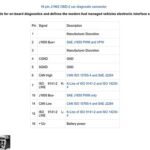The OBDII error code P0400 indicates a problem with the Exhaust Gas Recirculation (EGR) system, specifically an insufficient flow. This article delves into the diagnosis and solution of a persistent P0400 code on a 1997 Chevrolet Tracker, highlighting a common cause often overlooked.
The P0400 code is triggered when the Engine Control Module (ECM) commands the EGR valve open, but the expected change in manifold pressure, measured by the Manifold Absolute Pressure (MAP) sensor, doesn’t occur. This suggests a problem with the EGR system’s ability to recirculate exhaust gases. Several methods exist for monitoring EGR system functionality, such as: analyzing exhaust gas temperature, evaluating pintle position feedback voltage to the Power Control Module (PCM), and observing changes in O2 sensor voltage or intake manifold pressure. The Chevrolet Tracker relies on monitoring changes in manifold pressure.
The Tracker’s EGR system comprises several key components. The ECM controls the EGR vacuum solenoid, activating it to supply vacuum to the pressure transducer. This transducer modulates vacuum to the EGR valve based on exhaust backpressure, effectively controlling EGR flow according to engine load. Additionally, the EGR bypass solenoid, activated by the ECM during self-tests, applies full manifold vacuum to the EGR valve, maximizing exhaust gas flow into the intake manifold. This action should cause a noticeable voltage increase from the MAP sensor, which is monitored by the ECM. If this voltage change falls outside the predefined parameters, the P0400 code is set.
In this particular case, all EGR components—valve, pressure transducer, vacuum solenoid, and bypass valve—were new. Vacuum hoses were correctly connected, the MAP sensor functioned properly, and the ECM operated the solenoids as designed. Yet, the P0400 code persisted. Further investigation revealed that while the EGR valve opened and seemingly allowed exhaust gas passage, a subtle restriction within the system was the culprit.
Exhaust gas, drawn from the No. 4 cylinder exhaust manifold, travels a convoluted path through the cylinder head, into the intake manifold, through the EGR valve, back into the intake manifold via an EGR transfer tube, and finally into the intake airstream behind the throttle plate.
A common issue, especially in older vehicles, is carbon buildup at the EGR port behind the throttle plate. The temperature difference between hot exhaust gas and cooler intake air causes carbon to condense at this point, restricting flow. Although the restriction might seem minor, its impact on the entire system is significant, analogous to pinching a garden hose—even a small constriction reduces flow throughout.
In this instance, the solution was simple: cleaning the carbon buildup from the port behind the throttle plate. This seemingly minor fix restored sufficient exhaust gas flow, allowing the EGR system to pass the self-test and eliminating the persistent P0400 code. This case underscores the importance of thoroughly inspecting the entire EGR flow path, even when individual components appear functional. A seemingly insignificant restriction can disrupt the entire system, highlighting the importance of meticulous diagnosis in resolving OBDII error codes like the P0400.

